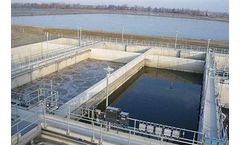biofilm monitoring Articles
-
Online biofilm monitoring by HydroBio® Advance in an open cooling water system
Download our new case study (CS 134) and learn how HydroBio® Advance optimized the biocide programme and improves the full plant efficiency through: Control of microbiological status with online biofilm monitoring. Optimization of the biocide treatment. Successful deposit control and so clean system. Improvement in cooling tower performance. Increase in control of operation. ...
-
Effects of pipe materials on biofouling under controlled hydrodynamic conditions
Experiments were carried out to investigate pipe material impacts on biofouling, at high effluent concentration levels and under controlled hydrodynamic conditions. Two velocities (0.4 and 0.8 m s−1) were used to monitor biofilm growth on polyethylene (PE) and polyvinylchloride (PVC) pipe walls, respectively. These conditions were established based on wastewater irrigation practices. A ...
-
Comparison of four methods to assess biofilm development
Two nondestructive methods of biofilm quantification (optical density via a flatbed scanner and biofilm thickness) have been evaluated and compared to two destructive methods (Crystal Violet staining after biofilm disintegration and dry weight). The methods were tested on biofilms that developed on a modified rotating biological contactor (RBC) that was inoculated with urban wastewater and fed ...
-
Does your cooling tower have a biofouling problem?
What’s growing in your tower? It’s important to be able to identify microbial biofouling in the industrial cooling systems that you treat. We know that biofouling is a bad thing … reducing the heat transfer performance of a cooling system, as well as causing microbially induced corrosion, harboring pathogens, and accumulating scale deposits. All these problems can lead to ...
By AMSA, Inc.
-
Mechanism and kinetics of biofilm growth process influenced by shear stress in sewers
Sewer biofilms play an important role in the biotransformation of substances for methane and sulfide emission in sewer networks. The dynamic flows and the particular shear stress in sewers are the key factors determining the growth of the sewer biofilm. In this work, the development of sewer biofilm with varying shear stress is specifically investigated to gain a comprehensive understanding ...
-
Chlorine requirement for biologically stable drinking water after nanofiltration
There is considerable interest in minimizing the chlorine residual in Japan's tap water because of increasing consumer complaints about the chlorinous odor of drinking water. However, minimization of the chlorine residual requires stricter control of biodegradable organics in finished water to ensure biological stability during water distribution. In this context, we investigated the ...
-
Using biofilms for monitoring metal contamination in lotic ecosystems: The protective effects of hardness and pH on metal bioaccumulation
Biofilms can make good bioindicators and biomarkers, offering a convenient tool to monitor metal contamination in streams that results from mine tailing sites. Biofilm metal content (Cu, Zn, Cd, Pb) as well as diatom diversity and the presence of teratologies (diatom abnormalities) were determined for biofilms from rivers with a variety of physico‐chemical properties across a metal ...
-
A Refinery saves 25% on biocide dosage by using HydroBio advance - Case Study
Real time determination and monitoring of biofilm in cooling systems 1. Keywords HydroBio Advance, Cooling system, Biofilm, Biocide consumption 2. Background This case study shows how the application of the HydroBio Advance is used to evaluate the real biocide demand of a cooling system in the petrochemical industry. Independent of the season the cooling system in a refinery was treated with ...
-
A Refinery saves 25% on biocide dosage by using HydroBio Advance
Real time determination and monitoring of biofilm in cooling systems 1. KEYWORDS HydroBio® Advance, Cooling system, Biofilm, Biocide consumption 2. BACKGROUND This case study shows how the application of the HydroBio® Advance is used to evaluate the real biocide demand of a cooling system in the petrochemical industry. Independent of the season the cooling system in a refinery was ...
-
Fate of
Salmonella Typhimurium in laboratory-scale drinking water biofilmsInvestigations were carried out to evaluate and quantify colonization of laboratory-scale drinking water biofilms by a chromosomally green fluorescent protein (gfp)-tagged strain of Salmonella Typhimurium. Gfp encodes the green fluorescent protein and thus allows in situ detection of undisturbed cells and is ideally suited for monitoring Salmonella in biofilms. The fate and persistence of ...
-
Influence of the shear stress and salinity on Anammox biofilms formation: Modelling results
Anammox biomass has a relatively long duplication time and low yield. This is an advantage because the production of surplus sludge is reduced; however it also implies that the process must be operated in reactors with very good sludge retention. Some of the systems used to improve biomass retention are based on biofilm reactors; therefore, the objective of this work was to study the ability of ...
-
Are you Flushing Money Down your Cooling Tower?
When it’s up and running properly, your cooling tower is the quiet workhorse and unsung hero of your water system. But neglecting regular inspections, cleaning, and maintenance can lead to hundreds of thousands of dollars down the drain. Here’s how to keep it running at optimum levels of efficiency and performance – both for cost savings and for the environment. Limited Margin ...
-
The Moving Bed Biofilm Reactor Sewage Plant - The Who, What, When Where, Why and How
The MBBR Sewage Plant - The Who, What When Where, Why and How If you’re looking into biological water treatment methods and which one could be the best for your application, perhaps you’ve come across moving bed biofilm reactor (MBBR) technology. You probably have a few general questions as to how it works and how it can help you meet your particular needs, but are having a hard ...
-
The MBBR Sewage Plant: The WHO, WHAT, WHEN, WHERE, WHY, and HOW
If you are researching biological water treatment methods and which one could be the best for your application, perhaps you’ve come across moving bed biofilm reactors (MBBR). You probably have a few general questions as to how it works and how it can help you meet your particular company or municipalities wastewater treatment needs, but are having a hard time finding answers while searching ...
Need help finding the right suppliers? Try XPRT Sourcing. Let the XPRTs do the work for you



